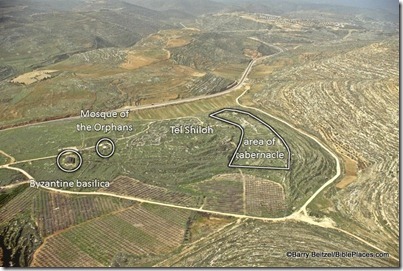Arutz-7 is reporting today on the excavation of biblical Shiloh.
A new archeological find at ancient Shilo fits in with the Biblical narrative regarding the war at Even Ha’ezer [Ebenezer], and could confirm scholars’ conjectures as to how Shilo was destroyed.
The First Book of Samuel does not say when and how Shilo, which served as the Israelite capital for 369 years, was destroyed. The latest archeological find at the Shilo site – a broken vase and remains of ashes from a fire – indicate large scale destruction. The remains are from the same period in which the War of Even Ha’ezer [Ebenezer] against the Philistines was waged.
Israel suffered a crushing defeat in that war, which is believed to have been waged near present-day Afek. The two sons of Eli the High Priest were killed, and Eli himself died upon hearing the news. Worst of all, the Holy Ark, which the Israelites had brought to the battleground, was taken by the Philistines.
Archeologists and scholars now have more evidence to back the assumption that after defeating the Israelites at Even Ha’ezer [Ebenezer], the Philistines advanced upon Shilo and sacked it.
Other Biblical passages, in Psalms and Jeremiah, confirm that Shilo was destroyed by Phlistines [sic].
A few comments:
1. The minimalistic reporting makes it impossible to evaluate the claim. The discovery of a broken vase and remains of ashes could indicate nothing more than the presence of a family hearth. Perhaps the archaeologists did find a destruction layer, but you have to believe that the journalist has evidence he was unwilling to share.
2. A destruction layer from the time of Samuel was already identified in Israel Finkelstein’s excavations in the 1980s. “This complex of buildings [in Area C] was destroyed by a violent conflagration whose traces were visible everywhere: charred floors and heaps of fallen bricks, sometimes more than one meter deep….As suggested by Albright following the Danish expedition’s excavations, this may be attributable to the Philistine destruction of the site (mid-eleventh century BCE)” (NEAEH 4: 1368).
3. The theory that the Philistines destroyed Shiloh in the aftermath of their capture of the ark at Aphek seems to be supported by the absence of Shiloh in the biblical narrative in the years of Samuel, Saul, and David. Its destruction by Philistines is suggested by its mention in two passages.
Psalm 78:60 — “He abandoned the tabernacle of Shiloh, the tent he had set up among men.”
Jeremiah 7:12–14 — “‘Go now to the place in Shiloh where I first made a dwelling for my Name, and see what I did to it because of the wickedness of my people Israel. While you were doing all these things, declares the Lord, I spoke to you again and again, but you did not listen; I called you, but you did not answer. Therefore, what I did to Shiloh I will now do to the house that bears my Name, the temple you trust in, the place I gave to you and your fathers.”
The Arutz-7 story, with a photo of a jar, is here.
